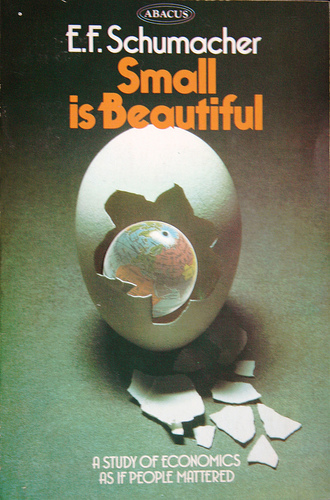
Usually Buddhists disapprove of the greed and excess of capitalism, but have little more to say. That does not lead to alternatives, just to ineffective, peripheral muttering.
If Buddhists are to address the centrality of economics in contemporary life and its privileged role as the discourse setting the terms for all other languages and discourses, we need to do better than to say that, like sin, we are against it.
We might start, not with moralizing, but by saluting the creative energies that constantly pour into renewing the engine of growth. Our contemporary capitalist economy is a collective work of genius, a product of the best minds concentrating their creative energies. The engine of modernity requires ever increasing consumption. That is possible only if new human needs are invented and come to be believed. This is a highly creative process, and it works with exactly the same human energies that meditation practice works with. The brand builders are the drivers of corporations. They determine from the outset what a corporation?s products are to be, how they are to be positioned. Buddhist meditators and brand strategists alike watch the minutiae of desire as it erupts and dissipates in human minds. So why moralize as the first and only move?
Capitalism is a global system dominated by large corporations, often transnational in their scope, plus a host of smaller businesses that the finance pages caB the minnows. Transnational corporations have come to dominate international trade and commerce and the minnows are just bit players. Even though these days a minnow can be anything from the mum and dad milk bar on the corner through to a specialised manufacturer employing a hundred workers and turning over $30 million a year.
Capital Triumphant
Throughout the English speaking world, governments have quietly surrendered any will to resist, regulate or even moderate the corporate concentration of wealth and power. No longer are there major political parties willing to oppose this global concentration. They know from experience that opposition to corporate power condemns them to the opposition benches, denying them their taste of power. In theory governments can still regulate, legislate and curb corporate excess, and they still speak as if they exercise real authority, but in practice they have abdicated. European governments are starting to do the same. Outside of Europe and the English speaking rich countries, governments seldom had much control over corporations in the first place, and are commonly subservient to the big corporate interests, and to their cronies.
Capitalism is always restless, dynamic, in flux, forever re-inventing itself in the endless pursuit of advantage, growth, competitiveness, the edge. This is highly seductive, because it forever holds out the promise of satisfaction, not just of our basic needs such as food or clothing, but with every hamburger or pair of jeans comes the invitation to make a lifestyle statement, a fashion statement, to be with the in-crowd. In the hierarchy of human needs, almost every ordinary sales transaction is a step towards self-actualisation. The promise of capitalism is that it is actually the force of nature, the outcome of our genetic programming. It?s only natural to believe I deserve better than this, better than what you have.
Yet, paradoxically, the message of the brand builders is that by consuming this product, you become more you, more individual, special, unique. You become fun to be with, free to think your special, unique thoughts. By consuming what everyone else consumes you assert your liberation, your spontaneity, your lovability.
A First Buddhist Response
This is an awesome energy to work with. Yet Buddhists usually shudder at it, turn away from it, try to renounce it or suppress it, and live conspicuously simple lives uncluttered by a . surfeit of stuff. That is a hinayana response, a response that is premised on a fear that the brand builders have real power, not only over our purses but also over our minds. It is a response enmeshed in the problem/solution mentality, the very mentality on which capitalism and modern rationality thrive.
As meditators, we do indeed find when we sit that we do expect much, as if it was our due. For starters, we treat meditation as a commodity, to be purchased by our investment of time on the cushion. This is spiritual materialism. We feel frustrat~d when peace of mind eludes us: isn?t that what meditation is all about? We might blame the dharma centre, or ourselves, and pledge to persist in the quest, to try harder. We tend, as modern Buddhists in a consumer society, to say advertising, marketing, brand building are merely the workings of greed, hatred and ignorance, the energies which bog us down in samsara. Rather like Christ?s answer to Satan, we say get thee behind me. We repudiate and deny the extent to which our habits are influenced by the powerful passions capitalism conjures with.
A Playful Response
A less fearful, more confident imd playful response might be to plunge into the stream of advertisements, images, metaphors, fantasies, and desires capitalism evokes. It?s a bit humbling to acknowledge how many brand names I know, and how far I have absorbed their message as to what emotions the brand conjures up. If I sit in meditation and let all this trash flood the mind, I cease wrestling with my protestant super ego, that duty-bound part of me that likes to think I am too intelligent to be swayed by advertising. If I sit here, and acknowledge those guys know how to press my buttons, because I do have the buttons to press. I do want to be liked, loved, respected, be the life ofthe party, be up to date, rather than a fat, balding red-faced old man.
The mythicisation of routine consumer goods demands more of us than thin lipped cqndemnation and sanctimonious declarations of renunciation such as forsaking the Porsche. If the finest minds, of our generation are hard at it in the ad agencies and marketing departments building brands on the heroic stories distilled from the entire narrative heritage of humanity, we need a more potent and playful response than wowserism. Condemnation we can leave to the appollonian retentives in the churches, and on the reactive left, the public moralists who know only what they are against.
A playful response is responsive, labile, fluid, energetic, funny. It is always a middle way, balanced between extremes. In this situation we might call the extremes triumphalism and victimism.
The triumphal version is, in the words of a recent marketing text, that there is a clearly structured system that all business and marketing professionals can follow, to un.derstand and replicate the deep archetypal meaning of their product category, and claim it for their brand.
The victim mentality is simply the obverse: taking us all to be the exploited victims of this all-powerful marketing psychology, passively helpless to resist this ultimate level of manipulation of our deepest dreams and desires. Naomi Klein in her book, No Logo, is just one of the outraged authors articulating this latest version of victimhood.
What the triumphalists and the victims share is unquestioning belief in archetypes, in their potency, universality as keys to fundamental human urges and drives. They accept uncritically the itemisations, lists and schema of Mircea Eliade and Joseph Campbell, and of Frazer?s Golden Bough before them, not to mention Jung?s essentialist grandiosity.
This is clearly nonsense. Empirically, it is manifest nonsense, as Hollywood has for at least a decade used Campbell formulaically to chum out sure-fire hits that more often than not flop because they are so creakily obvious in their hero-recipe. More basically, all efforts at cataloguing human nature invariably fail, because the cataloguers are but magnifying their own historically-bound, class-bound and gender-bound fantasies and projections, and claiming them as universals.
More basic yet is the assumption of all these famous cataloguers, collectors and arrangers of myth and symbol that human nature is the measure of all things, the self-evident benchmark of what is noble and worth striving for. This is a complacent, comforting mythos that ignores greed, aversion and denial as basic drivers of our being. Greed, ignorance and hatred are explained away as arising from self-existing evil, or genetics, or sociological outcomes of childhood deprivation. Whichever popular explanation you opt for, our innate propensity to behave badly is explained away. If it does exist, it is due to external factors, or is hard wired, programmed into us and therefore necessary and inescapable. The result is collective denial of responsibility, and as whole cultures and civilisations, a collective disbelief in transcendence.
More basically yet, the empowerment of a pantheon of fixed archetypes-the hero, the outlaw, etc.-as keys to human souls, actually disempowers us. It makes us creatures rather than creators. It denies the source of symbols in the mind. It denies the fertility and infinite variety of what we create and uncreate. It forgets that we live in a world of images, which includes not only the visible, sensual imagery we surround ourselves with,.but also our words. A brand is at its root a word, a word we learn to associate with what we desire. It is just a single word implanted firmly in mind, a word we know consciously, and ask for by name.
Idolatry of the Brand
The process of branding a product is the process of linking a set of symbols, such as images, habitual emotions etc, with other images such as brand names. We have little trouble recognizing the advertisement?s seductive imagery of freedom, rebellion, cool, or sexiness as symbols, but we tend to forget that the punchline: the brand name, is just another symbol, just another sign made by human minds.
Signs point, but they lack inherent existence, the Buddhists tell us. They are artifacts of the mind?s extraordinary expressive, communicative, creative capacity; but once they are out there we assume they self-exist, we reify, deify, and worship them. They can then enslave us. It is no accident that the word ?brand? means a mark seared by fire into flesh, and the quintessence of consumer desire.
To protest at our enslavement by brands is to make a moralistic objection that conceals the origin of brands, their fictive ontology as creations of human minds. Brands are not buttons connected to deep, immutable, hardwired human archetypes.
The classic Buddhist response goes deeper, to the source of all our imagery, in the nature of the mind. The Buddhists say if we relax enough, are open enough, and at the same time concentrated and on the ball, we experience not only the onrushing stuff/content of the mind but beyond it, the basic nature of mind, which we discover to be profoundly empty, yet luminously radiant and creative, even blissful.
This is a powerful, empowering discovery. It is the discovery that the fount of all imagery, all symbols, archetypes, brand associations, desires, hopes and fears is the sky-like expanse of the nature of mind, within which images boil up like clouds, and dissipate like clouds. We rediscover that we are creators, not creatures.
We then have the option of living, moment by moment, in the unadorned reality of the nature of the mind, of experiencing everything precisely, with utter clarity and, to quote Herbert Guenther, consummate perspicacity. We see the arisings, abdings and dissolutions of all our imagery happen, as a conjuror sees his own trickery. We have restored agency to ourselves. We see the essential emptiness of the archetypes. Jung may have embraced Buddhism; we need not return the embrace.
If Buddhists held only that all phenomena, all ideas, all images and symbols are empty, we might perhaps have to say the goal of practice is to live without illusions, amid the torrent of mental arisings, or better yet, in a calm tranquility in which mental arisings have been snuffed out like an extinguished candle.
But the Buddhists, especially the Tibetans, go further. Far from making the contents of mind problematic, to be wrestled into perspective, the mind?s ability to create images is celebrated as the innate capacity of the empty nature of mind to communicate, to connect with other minds and with the phenomenal world, rather than exist in isolation. The capacity to communicate is one of the fundamental aspects of Buddhahood, samboghakaya.
So the Buddhist approach is not to climb out of the onrushing river of imagery, but to be both in it and beyond it. Buddhists gradually familiarise themselves with the nature of mind, getting occasional glimpses that gradually grow in confidence and clarity. Meditators are reminded not to privilege emptiness, or make luminous communicativeness subordinate. There is no sense of original sin, of having made a mistake or having fallen into error. The confusion and din of neurosis are celebrated as being just as original as is the empty nature of mind. We didn?t after all make a wrong turn at the start, from which we forever struggle to retrace our steps. Life is not a quest for etiology. Time is but an image, a concept, a fiction made for its usefulness, but apt to become a prison. There is no ur-moment, no instantiation of origin, to be recaptured by diligent detective work.
Buddhism offers us a more basic response, in fact a gamut of responses, including the moral, and also a range of reflective tools to help us connect better with our basic being, and proceed from there to bigger questions of how shall we live. Morality and ethics arise naturally out of meditative experience, integral to the shift of perspective meditation generates, away from self-centredness towards inclusiveness.
Buddhism teaches us that the most basic process of a mind in the seductive grip of imagery is to either exaggerate or minimise. Whatever we encounter, internally or externally, is colourised to become even more attractive, or edited out and denied. Whatever we have conditioned ourselves to find attractive we add to and enhance; whatever we have programmed ourselves to feel aversion for, we minimise. Mostly, we have focussed on fetishised desire and seduction; without looking much at the flip side of denial. What we deny, individually and collectively, are the costs of our expanding universe of neurotic desire to have it all. The United States denies the reality that the global climate is heating, the ice is melting, and the seas are rising. It has simply been edited out of national consciousness. It?s not just the president, in cahoots with the oil companies, that finds such reality inconvenient. It is the entire country that fails to take seriously what everyone, at a certain level, accepts as scientifically valid. There?s a disconnect, a cognitive dissonance. Global climate change is seen as a fascinating scientific detective story; but people fail to connect it with the daily decision about how much heating oil their basement furnace consumes.
When we contemplate, sit on a meditation cushion, we discover experientially these disconnects and denials, and the dramatisations and seductions we set ourselves up for. We discover that our habitual strategising of life to leverage maximum advantage for numero uno has in
fact consistently led me to disappointment and grief, isolation, confusion, anxiety and self?defeat. We discover our buttons, how easily we fall for the promise that the next time, the next buy, the next relationship, it?s going to be better, this time it?s going to come good.
More profoundly, we discover the gap between me and you, self and other, subject and object, is not all that great. We discover that life is not a zero/sum game of winners and losers, and I have to win or all is lost. We discover that compassion is not a cost but starts at home with being more relaxed and accepting of myself, allowing me to be more generous and accommodating of others. We discover that we can let gc, give away what we hold most precious, and far from being bereft are set free.
Is a Buddhist Economy Imaginable?
Does such an understanding of human nature, freshly experienced in ourselves and our encounter with others, lead us to the possibility of a different sort of economy? Is there really any alternative to the onrush of contemporary mass capitalism? Are we collectively doomed to go faster and faster, until we reach exhaustion, both of resources and sanity, and then collapse?
Clearly, the individualistic Buddhist option, of opting out into conspicuous non- consumption, is not much of an alternative. It changes little and does not challenge the dominant paradigm. It is at this point that Buddhists tend to falter. Alternatives are hard to imagine.
If we turn to history, there is little to encourage us. Seven decades of Soviet-bloc socialism proclaimed the creation of Soviet man, who turned out to be as selfish and corrupt as anything to be found in capitalism. One could argue that from the outset this was not socialism but state capitalism, and China today persists in the state capitalist model.
Revolutions and renaissances notoriously denounce and repudiate the immediate past, seeking salvation in either a distant golden age or a distant utopian future. and fail. History offers us no successful utopias, and from a Buddhist point of view one might say the hope for a utopia is magical thinking, the wish for a total solution to all problems. All historical attempts at distributive justice, at redistribution of wealth, of ensuring everyone has equal access to education and wealth creation, have largely failed. One could shrug the shoulders and say it?s only human nature that we tend to be selfish and exclusive.
It is at this point that many fall silent, because it is part of scientistic modernity to accept that human nature is anti-social, that selfishness and even aggressiveness are hard wired genetically, and altruism is not natural. It is precisely at this point that Buddhism comes into its own, with its observation that we do naturally wake up to how self-defeating our selfishness is. We do have a natural capacity for love, altruism and standing in the shoes of others, capacities that can be trained and fostered by meditation practice. Such awakening is not only a subjective transformation; it also shifts the direction of economic behaviour.
Buddhist Economies in History
It ought to be possible to approach the search for a Buddhist economics historically, as there have been so many societies, over thousands of years, deeply influenced by Buddhism. Throughout Asia there have been economies influenced in various ways by Buddhism. Seldom do historians of Asia manage to depict the dynamics of those economies, and even less often have they asked whether Buddhism influenced the way the economy worked. Nonetheless the question can be asked, and some answers may be possible.
But first, we must be clear as to what might constitute a Buddhist influence on an actual, historical economy. We cannot look for utopias. Nor is it relevant to look for purely materialist outcomes, such as equality of wealth distribution, as if such a statist intervention from above were the yardstick of Buddhism in action. To look for equality, in large and complex societies, presupposes a powerful central state with the capability and the will to intervene for egalitarian purposes, and such states are a modern invention.
Steady-State Economies in Equilibrium
If history might yield useful examples, we must think with care about what we are looking for. Rather than seeking imperial edicts commanding a redistribution of wealth, we should look for consensually shared values, community-mindedness, a celebration of civic virtues, of generosity and altruism, inclusiveness arising from the common experience of the human condition.
Such a search wold be a vast undertaking, and perhaps end inconclusively. We could instead propose a more basic yardstick. Put simply, the fundamental stance of a Buddhist economy is equilibrium, which might also be called balance, or stasis, or a steady-state. Where a Buddhist society exists, in circumstances conducive to exponential growth and the concentrations of wealth and power that go with exponential growth, yet such growth does not occur, that is a Buddhist economy.
There are plenty of historical examples of what modern historians call stagnation, a puzzling failure to grow which requires explanation. Modern economics assigns a huge role to technology in enabling growth, and a major role to ecological constraints that, in the absence of modern technology, limit growth. In this view, ecology determines the limits to growth, and technology releases societies from those limits, liberating their inherent potential for growth.
From a Buddhist point of view it is not equilibrium that is problematic, and in need of explanation, it is the addiction to exponential growth as the solution to all human problems. History tells us that accumulation, of crop surpluses, then monetary wealth, enabling kings to recruit standing armies and centralise power, goes back at least 5000 years. Urbanisation, hierarchy, the hedonic treadmill, the endless quest for more, all go back almost as far as the invention of agriculture. Yet some societies resisted these worldwide trends. Maybe they had no choice. Their subsistence lifestyle was ecologically determined. That explanation is popular in this material age. Until the introduction of modern technologies, they were limited in what was possible. This presupposes that the urge for wealth, for me to have more than you, is innate, genetically preprogrammed.
Ecological determinism is reductionist and wrong headed. It rests on the modern assumption that humanity and nature are mutually exclusive categories of existence, and primitive people are slaves of nature, while modern people are masters of nature. Ecological determinists have looked at many areas, such as the inland of Australia, the tropical forests, and the open rangelands of the nomads, and quickly reached the conclusion that such environments are inherently low in productivity, suited only to low concentrations of human use unless modern technologies are brought in. Only very recently has careful fieldwork made it apparent that such areas, far from being marginal, are in fact highly productive and have been used both sustainably and productively by their inhabitants over long periods.
So we might consider a specific historical example: Tibet. Seldom in history have Buddhist values been so directly adopted by state power as in Tibet. Was the Tibetan economy a Buddhist economy? Was it an economy in equilibrium, and if so, was this because ecological constraints made equilibrium necessary, or was it a human choice?
The evidence is hardly conclusive, as this is a research question seldom asked or answered. We immediately enter contested territory. China says life in Tibet was poor, nasty, brutish and short for all but a privileged class o
f nobles and clerics. China says Buddhist Mongolia and Tibet were not only stagnant but also declining, and may well have died out altogether, crushed under the weight of feudal theocracy, had modernity, in the form of the Chinese Communist Party, not arrived.
The romantic obverse of this is that Tibet was a saintly land that cared not for things of this world, dedicating its entire energies to inner exploration rather than outer conquest of nature and material wealth. In the Hollywood version, Tibetans seem to spend their days caringly protecting worms from the spade.
If we are to find our way through such extreme projections, we need to remind ourselves of what we are (and are not) looking for. We are not looking for an earthly paradise, or egalitarian wealth distribution, or explicit policy statements couched in our modern language of steady-state economics, welfare economics, natural capitalism, ecological economics or distributive justice. We are looking for implicit assumptions, tacit meanings, basic world-views that defined the uses of wealth and more basically, how life?s ups and downs are to be accepted, or overcome by human will and effort.
Tibetan Neediness
If modern society is one in which new human needs are invented to keep pace with new technologies, we might ask how needy were Tibetans in Buddhist Tibet? Conversely, to what extent were they not merely passively resigned but actively embracing of their material standard of living?
This is not a defence of old Tibet. Few Tibetans today defend it. It is a question of seeking, despite the intense politicisation of the whole issue, some way of gauging the practical effect in economic life of the widespread and heartfelt belief in Buddhism.
When Tibetans look back, comparing Buddhist and Communist Tibet, one of the first things they say is that in old Tibet, despite great inequality there were no famines. Many Tibetans remember the terrible revolutionary years of desperate hunger, from 1959 to 1962, when Tibetans ate grass, roots, bark, boiled leather, and starved en masse. The absence of famine is no small matter, especially if we accept Tibetan estimates that the human population of the entire plateau was around six million people, a very full human usage of a high, cold and mostly arid plateau. The work of Nobel Prize winner Amartya Sen reminds us that famines are seldom unmitigated natural disasters, and that in the midst of famine there is usually plenty of food about, hoarded by the rich and powerful, while the poor have neither the income nor the political strength to access it. Sen strongly correlates democracy with an absence of famine, and conversely, correlates dictatorships with famine.
Tibetans say that in old Tibet there were many poor people, and beggars, but poverty and even beggary were not stigmatised as moral failings of individuals. Everyone knew that life is unpredictable, that the inexorable workings of karma may mean that today I am rich, but maybe tomorrow I will be poor. Everything rises and falls. Without much need of government intervention, still less of dedicated official institutions, people accepted a social responsibility to be generous to the poor and the beggars.
The big differences between rich and poor did not have strong connotations that the rich were inherently superior and the poor inherently inferior human beings. Farmers bonded to landlords maintained considerable dignity and freedom.
Tibet?s Place in Globalization
Tibet notably did not urbanise. This is remarkable, as there are ecological limits on what can be grown in Tibet, necessitating trade as essential to basic subsistence, and trade usually means market towns as the hub of urban growth. In Buddhist Tibet much trade was fairly local, self-contained, and enabled a high level of local self-sufficiency. Nomads each summer have surpluses of dairy products and wool to sell, and each autumn, surpluses of animal skins and meat. The farmers in nearby sheltered, watered valleys each summer have surpluses of grain. The trade in these commodities, at rates fixed by proverbial custom, was sufficient to supply most of the necessities of life. However, long distance trade was also integral to the Tibetan economy, with caravans of pack animals taking salt, wool, yak tails, horses, skins and other products to distant markets in India and China. They would come back laden with cotton, silk, tea and other goods in demand among Tibetans. Tibet rapidly became part of the global economy and thousands of tons of wool went annually, via Kalimpong and Calcutta, to Britain?s woolen mills. Communism put a stop to that.
This long haul trading required much organising. It required a banking system enabling merchants access to capital to accumulate goods to sell, and to meet the many expenses of the enterprise, paying workers and feeding animals, for many months, before a profit was made. It required economic intelligence to know the arbitrage opportunities, the margins to be had by buying at point A and selling at point B. There was also a need for grain silos and storehouses to hold surpluses until such time that they might be profitably sold.
These are all classic factors for the growth of market towns, as Skinner demonstrated for China. These hubs have opportunity to grow exponentially, and have often been driven to do so by the cost of money, by the merchants? need to service loans by maximising profits, hoarding commodities and guarding their secret commercial knowledge of comparative advantage. The entire modern world of infinitely expanding human needs can be traced back to such market towns.
Yet Tibet did not urbanise. Even the holy city?ofLhasa, at the time of China?s conquest in 1950, had a population of only 20,000, plus a constant flow of pilgrims in and out. What is most striking about the Tibetan economy is that all the functions of a market town were filled by the monasteries. They were the granaries, warehouses, banks, financiers, entrepreneurs and profit takers of Tibetan trade.
Throughout the twentieth century this was seen, both by European and Chinese observers, as proof of monastic venality, corruption, unhealthy worldliness, a dangerous mix of sacred and secular power. Undoubtedly, there is truth in these accusations. But if we look at the scope of wealth creation, and the uses of the wealth accumulated, a different picture emerges.
Wealth Creation in Old Tibet
If the lamas at the head of these monastic enterprises had opted for our familiar modem, competition-driven exponential growth, the option was there. All that would be needed in order to generate bigger surpluses and thus greater accumulation and concentration of wealth, would be to persuade nomads to slaughter animals in a modem way, namely to slaughter almost all male animals while very young in order to maximise the number of breeding females in a herd. Recent Chinese statistics show that to this day Tibetans sell or slaughter around 11 % of their yaks each year, compared with a Chinese average (for cattle) of over 20%; while 22% of Tibetan sheep are sold or killed each year, compared with 55 % for China. Despite a half-century of Chinese efforts at intensifying Tibetan meat production, Tibetans still resist, and prefer to keep their animals with them, on the hoof, to live out their days, as the best insurance a nomad can have against unpredictable blizzards. The modem world regards such practices as irrational, uncompetitive, unproductive and backward.
Wealth up in Smoke
The Tibetan economy does seem to have been in equilibrium, and Buddhism did moderate needs. The poor led simple lives materially, but the rich were not noted for routine conspicuous consumption such as is common among the cadre class today. Popular Buddhism
reminded people to think not just of this life, or just of one?s own needs, but offuture lives, and of the needs of all living beings. The bigger picture was always presented, as a reminder to consume in moderation. Nature was not external. The commonalities of fhe human and animal condition were emphasised. Herds of wildlife grazed with domestic yaks and sheep, unafraid of people. Fish were not caught. These are all, by today?s standards, primitive failures to maximise economic gain.
Tibetans could have opted for greater wealth creation had they chosen to. The material poverty of the Tibetans was not ecologically determined. The monasteries attracted wealth, and actively financed the wealth creation of the traders, yet the capital accumulated seldom became an end in itself, with a life of its own and an endless need to pursue higher returns, as is the norm in any modem economy. Much of the wealth accumulated by monasteries financed the daily expenses of running the monastery as an enterprise existing consensually for the welfare of the entire community and for the welfare of sentient beings generally. Much of the wealth went up in smoke in devotional butter lamps, or in goldplating of statues, in conspicuous spectacles of piety.
To Chinese and Europeans alike this was deeply offensive, a squandering of capital which could have been made the engine of exponential growth. From the 19th century on, visitors to Tibet almost uniformly expressed disgust at the parasitical monastic class, who seemed to produce nothing for the community in return for the donations, taxes and profits they received.
In any modern economy, capital assumes a life of its own, and becomes so important in its own right that everything is judged by it, or becomes a form of capital. Thus we talk of education these days as human capital formation, of the skies and rivers as natural capital, of our human heritage of custom and social bonds as social capital, in order to not be swept aside by the insistence that capital must always flow to where it generates maximum profit, and everything irrelevant to that may be swept aside.
In development economics, the hardest stage is the first, in which poor communities lack monetary capital to invest in infrastructure and intensification of production. Once capital begins to accumulate, as taxes in government hands or profits in enterprise hands, the dynamic of growth has begun, and it is easier to turn modest capital into major capital. Tibet clearly rejected this reific~tion of capital. Capital accumulation was episodic. Once it accumulated it was spent rather than being held aside to fulfil the law of the market that capital must generate maximal return.
In this sense, for all its inequalities, we can say Tibet was a Buddhist economy. It might seem that our definition of what constitutes a Buddhist economy is rather basic, and easily met. But in today?s world, a return to modest human neediness would subvert the entire dynamic of endless growth. If we all learned to moderate our needs, and take personal responsibility for acknowledging our desires but not solidifying them into needs or rights, the accelerating inflation of contemporary capitalism would implode.
Once more, this is not a moral injunction. Buddhism begins with the assumption that no matter how much leather we cover this prickly world with; there will still be thorns, so the best protection is the more modest alternative, to put leather on our feet. Attend first to the mind, for it is the mind that can instantly be anywhere, imagine anything, deliver us into heaven or hell in a flash. If we are to be happy, productive and of genuine help to others, we need to clean up our act, take responsibility not as a moral duty but as a way of discovering what really matters, and what clutters us up.
As we practice, we experience ourselves unvarnished, prior to the colourisation and editing. We experience ourselves as we are, without it feeding into the never-ending soap opera story line. We experience rawness, soft spots, unedited. We discover our ordinariness and foolishness. We soften and discover more space for others, we become more receptive, better able to stand in their shoes, sense where they are at, and respond appropriately.
We see the obsessive repetitiveness of our fantasies, our willingness to be seduced by the promises of brands. We experience our self-pity, our desire to be treated as someone special, given preferential treatment by corporations whose promise is to treat everyone as special, which is a logical nonsense. Our fantasies lose their urgency, their neon-lit colours fade, we discover that having ditched our boring old partner, we have chosen another in the image of the last one. We awaken.
For Buddhists the capacity, indeed the inevitability, of awakening is a given. This is where Buddhism is actually different. Awakening is not a distant unattainable goal achieved only by cultural heroes, by unattainable archetypes. Awakening from our self-enclosing reverie is never more than a breath away. Momentary glimpses of awakening are not at all uncommon. In such moments we know our striving, strategising, yearning are all irrelevant, because things are as they are, and that?s it.
Deflating the Modern Economy
As the fantasies become less lurid, and the editing and denial less automatic, we return to unadorned reality, experienced moment by moment, and get on with whatever comes next. We cease being drama queens and do the dishes; we stop worrying about the meaning oflife and feed the dog. We take responsibility for our needs, wants, desires and fantasies. We cease to be available to the brand builders. Our hot buttons are unplugged. Our footprint on the earth is less heavy, more mindful, we consume less, not because it is a moral imperative but because we have tired of the endless promise and unfulfilment of capitalism. We get on with life, softening further, opening up.
This is powerfully subversive stuff. We seldom transpose such micro transformations to the macro scale to see how subversive it is. Usually, we just say social change begins with changing ourselves, because it is only when we can take care of ourselves that we can live up to our ideals of caring for others. That in itself is a big enough agenda, so we don?t go beyond, and scale it up to a scenario of how it would be if a lot of people forsook consumption and took up reflection.
What makes this so subversive is that capitalism requires constant growth. Equilibrium, a steady state, in which we make and consume as much this year as last year, is death. This is why capitalism is so restless, revolutionary, so intent on creative destruction, so unable to sit still. We mistakenly call capitalists conservatives, whereas they are in fact the most revolutionary of systems, forever craving the new, needing excitement, whipping up adrenalin, seeking out the next big thing, the category-killer.
Buddhist economics is part of our general recovery from addiction, from assuming the answers to our problems are out there. One of the outcomes of meditation is equanimity, in which the restless energy of the mind averting itself from the unpleasant, and craving the pleasant, has subsided. With equanimity, they say, whether we are praised or blamed, we can react the same. Our sense of confidence, responsiveness and openness no longer require that we be surrounded by nice people, and shielded from nasty folk. We have discovered an inner strength and flexibility that are no longer dependent on getting our external causes and conditions just so.
Equanimity and equilibrium both suggest balance, steadiness, and a clarity that is not clouded by addictions and neurotic neediness for more stuff. Now we have the supposedly weightless new economy of the cyber age. It weighs heavily
on us by seductively persuading us to invent needs we never even imagined only a few years ago. There is little new about the new economy, except its addictive speediness and literalist insistence that answers to our needs are out there, not within.
When we discover our yearnings for magical shortcuts and the seductions of modernity, we need not recoil in moralistic horror. We need not zealously reprogram ourselves to need less.
If we get on with discovering our basic nature, our addictions give us up. A Buddhist economy comes into being as we learn to live economically, simply because life is short, and there is so much that is worthwhile in life that the life of the mall rat, the e-commerce deal maker, the day trader or data dandy fades.
Is there a way I can let the brand builders tell me something about myself? They seek out my response. In turn I discover my responsiveness. I discover how I fill in the dots, complete the picture, put myself in their picture, win the girl and ride off into the sunset. Discovering my responsiveness is the discovery of my creativity, the power of my imagination, my ability?to colourise my world. The discovery of responsiveness is the beginning of greater confidence and responsibility, in my ability to make it up as I go along, or alternatively remain a prisoner of predictable habit.
Responsiveness is a fundamental discovery for Buddhists, a joyful discovery that the script of my life, and of the next moment, far from being written for me, is in my hands. I can choose how to respond, and the range of possible responses is infinitely varied. This is a somewhat tantric approach to capitalism, which acknowledges the richness of the imagery constantly being presented to me, the endless parade of brand names and their associations.
The tantric approach admits these energies into our lives, and by fully experiencing the responses they invoke, we discover their nature, which is dreamlike, empty of substance. We discover that it is a fantasy world we inhabit, and only a small part of the fantasy is given to us, most is our own work. We discover our ability to create, to visualise, to become, in the mind?s eye, the warrior, the great lover, the cool dude, the great nurturer, the sublime meditator, whatever turns you on.
In tantra, these creative abilities are harnessed in a programmatic way, in the visualisation of deities, often in an obsessively detailed way that matched the obsessive force of our habitual fantasies. We dissolve the deity and all divine qualities into ourselves, and discover what had seemed stuck, stale and unworkable in our lives is actually labile, responsive and workable.
Passions driving us to self-destructive behaviours turn out to be profound wisdoms, which can accomplish anything. It is no longer a question of ridding ourselves of our embedded niche in the capitalist system, but of moving fluidly, gracefully, spontaneously, even effortlessly with those energies, seeing them as both powerful and phantom-like, insubstantial.
From
Santi Pracha Chamma Essays in honour of the late Puey Ungphakorn Page 317-329










